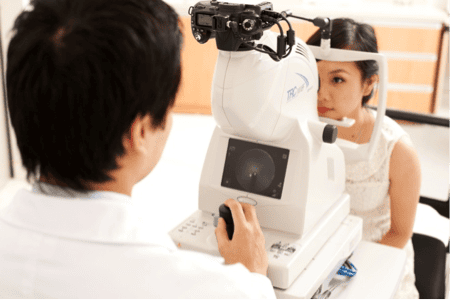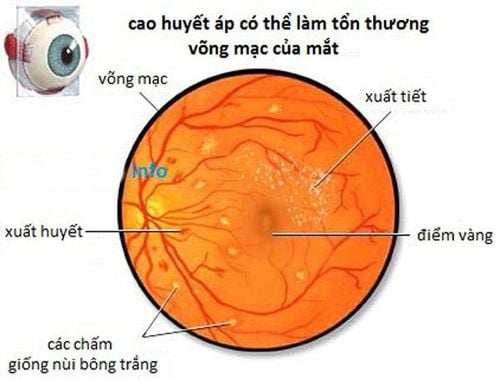This is an automatically translated article.
The article was professionally consulted by Specialist Doctor I Nguyen Thi Bich Nhi - Ophthalmologist - General Surgery Department - Vinmec Nha Trang International General Hospital.Eye conjunctival tumor is a tumor arising from the conjunctiva which can be benign or malignant, only affecting aesthetics or affecting the function of the conjunctiva, sometimes obstructing the vision of the eye. Eye conjunctivitis if not detected early and treated effectively can cause many serious consequences.
1. Classification of conjunctival tumors
People divide eye conjunctiva into 4 types: sessile papilloma, pedunculated papilloma, conjunctival mucinous tumor, conjunctival melanoma.Stemless papilloma: This type of tumor often occurs in young people. The basic feature of sessile tumors is the appearance of many small papillary lesions growing in clusters or singly, with a pale pink color. Common locations are the conjunctiva and the conjunctiva of the eyelids. The tumor is caused by HPV type 6 and type 11 virus in the conjunctiva. May regress spontaneously, or recur after surgical resection. Stem papilloma: Stem papilloma is represented by proliferation of multilobed epithelium, each lobe has a central blood vessel like a strawberry, surrounded by squamous cells, and a layer of squamous epithelial cells. Nonkeratinizing cells contain some mucinous secreting cells, which are prone to dysplasia. Tumors of this type often have the ability to recur after surgical removal. Conjunctival mucinous tumor: The cause can be congenital or acquired. The basic feature is the proliferation of conjunctival epithelial cells forming a mucinous cavity. Tumors often have no symptoms. Treatment of conjunctival mucinous neoplasms by surgical resection. Conjunctival melanoma: Common site in the conjunctiva of the eyeball, brown, asymptomatic. U little change in size and color. Follow-up does not require treatment.

U nhú có cuống được biểu hiện bằng sự tăng sinh của biểu mô dạng nhiều thùy
2. Causes of eye conjunctival tumor
Ultraviolet rays Tumor location often appears in the lash line and corneal margin because this is the area most susceptible to sunlight irritation. Ocular conjunctival tumors can arise from dysfunction of stem cells and from mutagenic agents such as UV light causing mutations in the TP53 gene.An immunological study shows that UV radiation may play a role in stimulating proteolytic enzymes such as: MMPs (matrix metalloproteinases), which inhibit cancer-related TIMPs.
HPV (Human Papilloma Virus) HPV is a virus that causes cervical cancer, but for ocular surface squamous cell tumors, it has not been identified. Biopsy and histological analysis showed that low-risk strains of HPV types 16 and 11 were associated with ocular conjunctival tumours. High-risk strains of HPV types 16 and 18 are also associated with conjunctival papillomas found in high-grade dysplasia and invasive squamous cell carcinoma of the conjunctiva.
3. Methods of treatment of conjunctival tumors of the eye
The important principle is early and correct detection and treatment, which has the prospect of complete recovery, insignificant ocular disfigurement and low cost.Surgery is a suitable modality for conjunctival benign tumors and conjunctival lipomas, without the need for radiation and chemotherapy. Depending on the size, the conjunctival benign tumor can be removed by laser, electrocautery or knife. As for malignant conjunctivitis, the treatment is more complicated, but if detected early, there are still positive results. For conjunctival tumors with extensive invasion, the surgery is very complicated, even forcing to dredge the entire eye socket to save the patient's life, then cosmetic correction.
When the conjunctival tumor has metastasized to the lymph nodes before the ear or below the chin, the survival rate is very low.

Khám và điều trị mắt tại bệnh viện Đa khoa Quốc tế Vinmec
If these tumors become large enough to affect vision or cause persistent discomfort, they can be surgically removed by an ophthalmologist in a non-hospital procedure. They are also often removed for cosmetic reasons.
Vinmec International General Hospital with a system of modern facilities, medical equipment and a team of experts and doctors with many years of experience in neurological examination and treatment, patients can completely peace of mind for examination and treatment at the Hospital.
Doctor CKI Nguyen Thi Bich Nhi has nearly 10 years of experience in the eye field. Treatment of medical eye diseases as well as eye surgery such as: pterygium, entropion, milia, glaucoma and cataract surgery by Phaco method. Besides, it also treats diabetic retinopathy by intraocular Anti-VEGF injection and ophthalmic surgery. Currently, the doctor is an Eye Doctor in the Department of Medical Examination - Internal Medicine, Vinmec Nha Trang International General Hospital.
To register for examination and treatment at Vinmec International General Hospital, you can contact Vinmec Health System nationwide, or register online HERE.
SEE MORE
Conjunctivitis of the eye: Causes, symptoms, treatment and prevention Bacterial conjunctivitis should use what kind of eye drops? What to do when you have an allergic reaction to the skin around your eyes?













